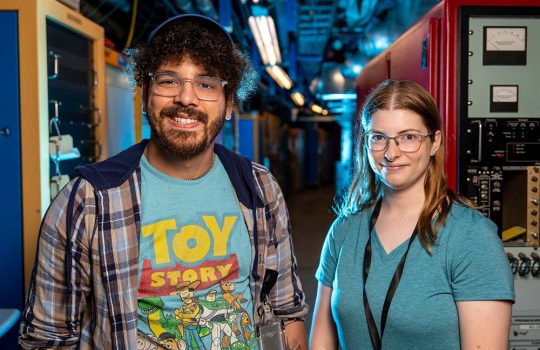
Roger Dixon and Erik Ramberg (third and fourth from left) have directed Fermilab’s successful Saturday Morning Physics for more than 20 years. Now they pass the torch to Elliott McCrory (far left) and Sowjanya Gollapinni (not pictured). Suzanne Weber (second from left) has been a pillar of the program, serving as coordinator since 1990. Photo: Dan Garisto
Over the past 37 years, local students have spent their Saturday mornings not in front of a TV watching cartoons, but in front of a blackboard, learning physics.
Since its inception in 1980 by then-Fermilab Director Leon Lederman, Saturday Morning Physics has been one of the most popular outreach initiatives at Fermilab. It has seen thousands of students pass through its 10-week-long programs, each of which regularly draws around 150 participants. During the course, students are exposed to topics from the history and practice of science to quantum mechanics to neutrino research at Fermilab.
Several copycat programs as near as the University of Michigan and as far as Darmstadt, Germany, attest to the program’s success instilling an appreciation of science and understanding of physics.
Neither snow nor rain nor heat have ever stopped the classes of Saturday Morning Physics, whose website warns students that “class is never cancelled due to weather.” According to Fermilab physicists Roger Dixon and Erik Ramberg, who have been directors of Saturday Morning Physics for more than 20 years, class has been cancelled only once: during the government shutdown of 2013.
This year, Dixon and Ramberg will pass down their directorial duties to University of Tennessee, Knoxville, physicist Sowjanya Gollapinni and Fermilab physicist Elliott McCrory. Gollapinni is a member of the MicroBooNE neutrino experiment, while McCrory, who works on Fermilab accelerators, brings with him nearly three decades of experience in training students through the Summer Internships in Science and Technology program.
While much of the physics that Dixon and Ramberg have taught has remained the same, the course has changed in other ways.
“Women joining has certainly increased over the years. It was very rare that we had more than five or six per session” in the early years, said Suzanne Weber, who has coordinated the program since 1990. Now, nearly half of each class is made up of female students.

Fermilab scientist Dan Hooper teaches the first class of Saturday Morning Physics in 2017. Photo: Elliott McCrory
Moving forward, McCrory and Gollapinni will work to continue making Saturday Morning Physics inclusive.
“We’re considering how we can add a lecture in Spanish,” McCrory said.
For Gollapinni, the importance of the lecturers as role models can’t be understated.
“It’s important for them to see all types of role models,” she said. “As a woman myself, seeing a female role model speak matters to the extent that it makes you feel like you can do anything, because you see a person like you, who has reached higher points in their career.”
Both McCrory and Gollapinni, a member of the community of university scientists who use the Fermilab for their research, also emphasized the need to experiment with the course and try new approaches to teaching physics.
“When we talk about particle physics — we’re studying essentially invisible things. So how do we know that they’re really there? It’s by the scientific method. We want the lecturers to at least touch on that concept throughout the year,” McCrory said.
Demos and other hands-on activities like tours that break up the standard two-hour lecture will also be emphasized as learning aids, Gollapinni said.
Dixon and Ramberg said they look forward to seeing where McCrory and Gollapinni take the venerated program.
“The thing that I always told the parents, which I always believed, is that the program was as much for us as it was for the kids,” Dixon said.
“This is one of the greatest tools to connect the laboratory with the community,” Ramberg said. “It really affects generations of kids.”



